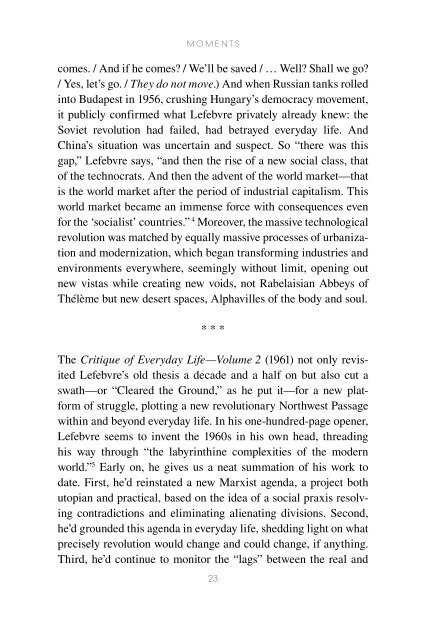Henri Lefebvre: A Critical Introduction - autonomous learning
Henri Lefebvre: A Critical Introduction - autonomous learning
Henri Lefebvre: A Critical Introduction - autonomous learning
You also want an ePaper? Increase the reach of your titles
YUMPU automatically turns print PDFs into web optimized ePapers that Google loves.
M o M e n t s<br />
comes. / And if he comes? / We’ll be saved / … Well? Shall we go?<br />
/ Yes, let’s go. / They do not move.) And when Russian tanks rolled<br />
into Budapest in 1956, crushing Hungary’s democracy movement,<br />
it publicly confirmed what <strong>Lefebvre</strong> privately already knew: the<br />
Soviet revolution had failed, had betrayed everyday life. And<br />
China’s situation was uncertain and suspect. So “there was this<br />
gap,” <strong>Lefebvre</strong> says, “and then the rise of a new social class, that<br />
of the technocrats. And then the advent of the world market—that<br />
is the world market after the period of industrial capitalism. This<br />
world market became an immense force with consequences even<br />
for the ‘socialist’ countries.” 4 Moreover, the massive technological<br />
revolution was matched by equally massive processes of urbanization<br />
and modernization, which began transforming industries and<br />
environments everywhere, seemingly without limit, opening out<br />
new vistas while creating new voids, not Rabelaisian Abbeys of<br />
Thélème but new desert spaces, Alphavilles of the body and soul.<br />
* * *<br />
The Critique of Everyday Life—Volume 2 (1961) not only revisited<br />
<strong>Lefebvre</strong>’s old thesis a decade and a half on but also cut a<br />
swath—or “Cleared the Ground,” as he put it—for a new platform<br />
of struggle, plotting a new revolutionary Northwest Passage<br />
within and beyond everyday life. In his one-hundred-page opener,<br />
<strong>Lefebvre</strong> seems to invent the 1960s in his own head, threading<br />
his way through “the labyrinthine complexities of the modern<br />
world.” 5 Early on, he gives us a neat summation of his work to<br />
date. First, he’d reinstated a new Marxist agenda, a project both<br />
utopian and practical, based on the idea of a social praxis resolving<br />
contradictions and eliminating alienating divisions. Second,<br />
he’d grounded this agenda in everyday life, shedding light on what<br />
precisely revolution would change and could change, if anything.<br />
Third, he’d continue to monitor the “lags” between the real and<br />
23
















